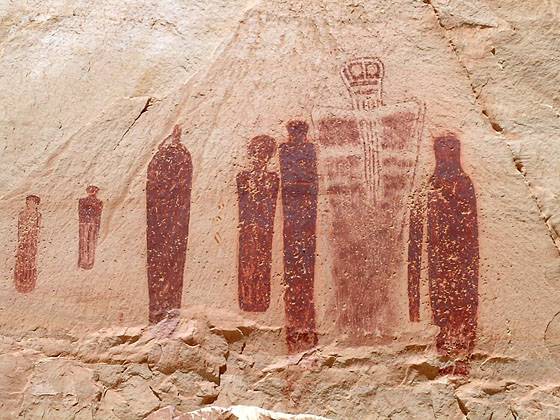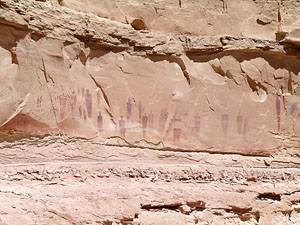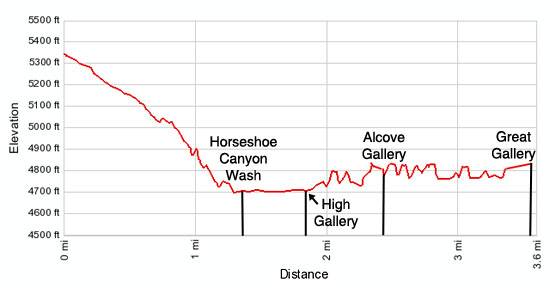Details: The Great Gallery in Horseshoe Canyon 
Distance: 7.2 miles (round trip)
Horseshoe Canyon District, Canyonlands National Park, near Canyonlands in Southeast Utah
Hike Facts
- Distance: 7.2 miles (round trip)
- Elevation: 5,350-ft. - 4,690-ft.
- Elevation Gain: -660-ft.
- Difficulty: moderate
- Trail Highlights: See Trail Intro
- Basecamp(s): Canyonlands / Moab
- Region: Southeast Utah

A nice hike to the Great Gallery, a phenomenal Barrier Canyon style rock art panel in a remote, detached unit of Canyonlands National Park.
Horseshoe Canyon

This hike visits some truly amazing rock art panels. Please treat all rock art you discover with reverence and respect so that it may be enjoyed by future generations. Rock art is extremely fragile and easily damaged. Never touch rock panels as the oil on your fingers can speed the erosion of the rock art. Do not vandalize the panels by taking latex mold prints or rubbings from rock art or adding modern additions.
Horseshoe Canyon is part of a detached unit of Canyonlands National Park, added in 1971 to protect the area’s incredible trove of rock art. Access to the canyon is along an old jeep road, built for oil exploration in the 1920’s. If you look across the canyon during the descent you will see portions of the old road climbing up the other side. No oil was found in the area and today the road severs as a good route down into the canyon.
The old road into the canyon starts on the southwest side of the trailhead parking area (see driving directions). Follow the road as is descends on moderate grades across slickrock and dirt, dropping 650-ft. in 1.4 miles to the canyon floor. Along the way pass a water tank used by sheep ranchers at 0.6 miles and vestiges of the piping system used to fill the tank by siphoning water from the canyon’s wash. Just before the water tank on the left side of the trail are fossilized dinosaur tracks surrounded by a small ring of stones.
Upon reaching the canyon floor the trail heads south and then southwest up the canyon, traveling along the wash and its adjacent sandy benches. Soaring sandstone walls tower overhead. Scattered copses of cottonwoods grow along the wash. Depending on the time of year, Barrier Creek, the intermittent stream running along the canyon bottom, may contain isolated pockets of water.
As you proceed down canyon pass a junction with the old road heading up the left (east) side of the canyon. Flooding and washouts have rendered the road unusable to vehicles.
At 1.8 miles look for a side trail heading left (southeast) to the aptly named High Gallery, a rock art panel located high on the canyon’s sandstone wall. The panel’s faded red pictographs depict animals and human figures. Just beyond, on the opposite (right) side of the canyon is the Horseshoe Shelter Gallery, an interesting pictograph panel sheltered by an overhang. The panel includes strange figures and one animal that looks like a dog. Be sure to look for a spur trail heading right to a smaller panel with images of elk, a bison and hunters.
After enjoying these two panels continue wandering along the canyon bottom, keeping an eye out for a large alcove on the right along the canyon’s western wall, 2.4 miles from the trailhead. This panel of red pictograph with human-like figures is a little faded and, unfortunately, partially damaged by graffiti.
Beyond the Alcove Panel follow the wash’s twist and turns for 1.2 miles to the canyon’s crown jewel, the Great Gallery, protected by a shallow overhang on the right (northwestern) wall of the canyon, 3.6 miles from the trailhead. This large panel of pictographs and petroglyphs, measuring 200-ft. long by 15-ft high, is considered to be one of the best preserved collections of Barrier Canyon style rock art in the country.
The panel features 20 life size figures without arms and legs, some over 7-ft tall. Many of these figures are drawn with elaborately decorated torsos. In all there are over 80 images, including animals and some unidentifiable objects, depicted in the panel in various shades of red, white and brown.
Visitors should plan on spending some time at the site to admire the panel’s fascinating images. It is interesting to speculate on the origins of the forms in the panel, are they humans, deities, or spirits? What was the canyon’s environment when the images were drawn on the canyon walls? How long ago were the images drawn and etched on the walls? Although the exact date when the images were drawn is not known, the panel is believe to be between 2000 and 4000 years old.
It is hard to pull yourself away from this amazing site. When you do, simply retrace your steps back to your vehicle. Keep in mind you need to climb out of the canyon the return trip.
The best time to hike to the Great Gallery is during the spring and fall when temperatures are milder. Hiking is not recommended during the summer months when temperatures often exceed 100 degrees F. Be sure to carry plenty of water. Do not depend upon finding water along the way.
Be forewarned that you will spend as more time driving to the trailhead than hiking. Parties that enjoy car camping should consider spending a night at Goblin Valley State Park to shorten the trip. Campsites in the park can be reserved at Reserve America.
Elevation Profile

Driving Directions
Note: Two-wheel-drive vehicles can typically travel the 30 miles of graded dirt/sand road from Utah Highway 24 to the trailhead. Rain or winds causing the sand to shift can quickly change the road conditions from two-wheel-drive to four-wheel-drive. Call (435) 259-2652 between 8am and 4:30pm to get an update on current road conditions.
From Moab, UT: Drive north on US 191 for 31.5 miles and turn left (west) on I-70 W. Follow I-70 west for 32.5 miles to exit 149 for Utah 24 West to Hanksville. Travel on UT-24 W for 25 miles and turn left (southeast) on County Road 1010 / Lower San Rafael Road. Signs on the highway point toward the Hans Flat Ranger Station. (The turn is 0.6 miles past the turn for Goblin State Park.) Follow the graded dirt road for 31 miles to the Horseshoe Canyon trailhead parking area. Note: there will be a “Y” intersection 20.2 miles from UT-24. Bear left at the intersection toward Horseshoe Canyon. The right fork leads to the Hans Flat Ranger Station.
Expect the drive to take about 3.5 hours from Moab. The drive along the dirt road to the trailhead will be slow. Depending on when it was last graded, sections of the dirt road may be covered with loose sand and contain rough washboards. Note: The dirt road may become impassable during storms.
From Hanksville, UT: Drive northeast on UT-24 for 16.2 miles and turn right (southeast) on County Road 1010 / Lower San Rafael Road. Signs on the highway point toward the Hans Flat Ranger Station. Follow the graded dirt road for 2.0 miles to an intersection and turn right again and drive 28.4 miles to the Horseshoe Canyon trailhead parking area. Note: there will be a “Y” intersection 19.9 miles from UT-24. Bear left at the intersection toward Horseshoe Canyon. The right fork leads to the Hans Flat Ranger Station
Expect the drive to take about 2 hours and 20 minutes from Hanksville. The drive along the dirt road to the trailhead will be slow. Depending on when it was last graded, sections of the dirt road may be covered with loose sand and contain rough washboards. Note: The dirt road may become impassable during storms.
From Torrey, UT: Drive east on UT-24 for 64.2 miles and turn right (southeast) on County Road 1010 / Lower San Rafael Road. Signs on the highway point toward the Hans Flat Ranger Station. Follow the graded dirt road for 2.0 miles to an intersection and turn right again and drive 28.4 miles to the Horseshoe Canyon trailhead parking area. Note: there will be a “Y” intersection 19.9 miles from UT-24. Bear left at the intersection toward Horseshoe Canyon. The right fork leads to the Hans Flat Ranger Station
Expect the drive to take about 3 hours and 15 minutes from Torrey. The drive along the dirt road to the trailhead will be slow. Depending on when it was last graded, sections of the dirt road may be covered with loose sand and contain rough washboards. Note: The dirt road may become impassable during storms.
Trail Resources
Trail Intro / Trail Photo Gallery / Trail Map
Basecamp(s) Information:
Canyonlands / Moab
Region Information:
Southeast Utah
Other Hiking Regions in:
Utah